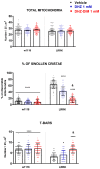Neuroprotective Effects of the Nutraceutical Dehydrozingerone and Its C2-Symmetric Dimer in a Drosophila Model of Parkinson's Disease
- PMID: 38540694
- PMCID: PMC10968126
- DOI: 10.3390/biom14030273
Neuroprotective Effects of the Nutraceutical Dehydrozingerone and Its C2-Symmetric Dimer in a Drosophila Model of Parkinson's Disease
Abstract
Parkinson's disease (PD) is a neurodegenerative disorder characterized by the loss of dopaminergic neurons responsible for unintended or uncontrollable movements. Mutations in the leucine-rich repeat kinase 2 locus contribute to genetic forms of PD. The fruit fly Drosophila melanogaster carrying this mutation (LRRK2-Dm) is an in vivo model of PD that develops motor impairment and stands for an eligible non-mammalian paradigm to test novel therapeutic approaches. Dehydrozingerone (DHZ) is a natural phenolic compound isolated from ginger and presents anti-inflammatory, antioxidant and neuroprotective properties, making it a potential therapeutic target for PD. We administered DHZ and its C2-symmetric dimer (DHZ-DIM) at 0.5 and 1 mM for 14 and 21 days in the LRRK2-Dm, with the aim of assessing changes in rescuing motor behavior, brain dopaminergic neurons, mitochondria and synapses (T-bars). The shorter treatment with both molecules revealed efficacy at the higher dose, improving climbing behavior with a prevention of dopaminergic neuronal demise. After 21 days, a recovery of the motor disability, dopaminergic neuron loss, mitochondrial damage and T-bars failure was observed with the DHZ-DIM. Our data indicate that the DHZ-DIM exerts a more potent neuroprotective effect with respect to the monomer in LRRK2-Dm, prompting further investigation of these compounds in rodent models of PD.
Keywords: Drosophila melanogaster; LRRK2; Parkinson’s disease; dehydrozingerone; hydroxylated biphenyls; natural compounds; neuroprotection; nutraceutical compounds.
Conflict of interest statement
The authors declare no conflicts of interest.
Figures









Similar articles
-
Glial Nrf2 signaling mediates the neuroprotection exerted by Gastrodia elata Blume in Lrrk2-G2019S Parkinson's disease.Elife. 2021 Nov 15;10:e73753. doi: 10.7554/eLife.73753. Elife. 2021. PMID: 34779396 Free PMC article.
-
Neuroprotection by the Immunomodulatory Drug Pomalidomide in the Drosophila LRRK2WD40 Genetic Model of Parkinson's Disease.Front Aging Neurosci. 2020 Feb 13;12:31. doi: 10.3389/fnagi.2020.00031. eCollection 2020. Front Aging Neurosci. 2020. PMID: 32116655 Free PMC article.
-
Dietary Amino Acids Impact LRRK2-Induced Neurodegeneration in Parkinson's Disease Models.J Neurosci. 2020 Aug 5;40(32):6234-6249. doi: 10.1523/JNEUROSCI.2809-19.2020. Epub 2020 Jun 30. J Neurosci. 2020. PMID: 32605938 Free PMC article.
-
Exploring the Efficient Natural Products for the Therapy of Parkinson's Disease via Drosophila Melanogaster (Fruit Fly) Models.Curr Drug Targets. 2024;25(2):77-93. doi: 10.2174/0113894501281402231218071641. Curr Drug Targets. 2024. PMID: 38213160 Review.
-
Disease model organism for Parkinson disease: Drosophila melanogaster.BMB Rep. 2019 Apr;52(4):250-258. doi: 10.5483/BMBRep.2019.52.4.204. BMB Rep. 2019. PMID: 30545438 Free PMC article. Review.
Cited by
-
Dehydrozingerone Improves Mood and Memory in Diabetic Mice via Modulating Core Neuroimmune Genes and Their Associated Proteins.ACS Pharmacol Transl Sci. 2025 May 19;8(6):1694-1710. doi: 10.1021/acsptsci.5c00046. eCollection 2025 Jun 13. ACS Pharmacol Transl Sci. 2025. PMID: 40534667
References
MeSH terms
Substances
Grants and funding
LinkOut - more resources
Full Text Sources
Medical
Molecular Biology Databases

